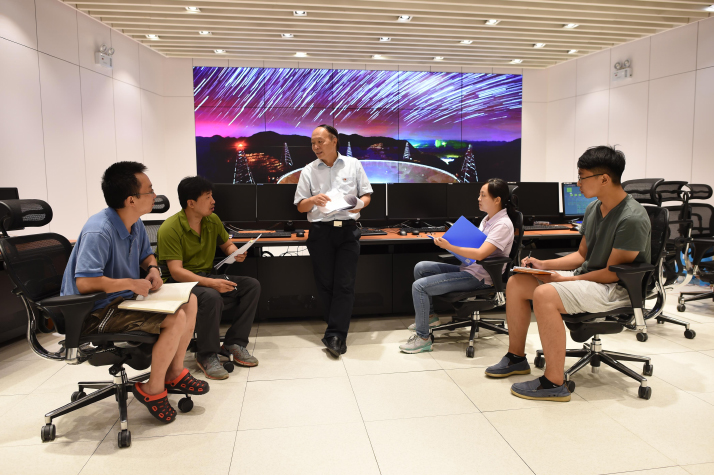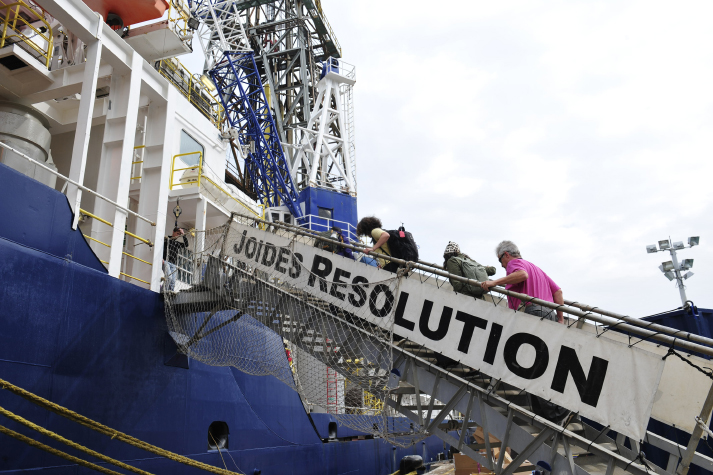| Lifestyle |
| Taking on Mega Science | |
| China aims to contribute to large international science projects | |
|
|
 Researchers hold a discussion in the control room of FAST, the world's largest radio telescope located in southwest China's Guizhou Province, on August 10, 2017 (XINHUA)
When a dozen scientists gathered in Beijing in early April for a discussion on the Meridian Project, they knew that new opportunities were beckoning. The Meridian Project is a space-monitoring initiative proposed by Chinese scientists. Under it, an interdisciplinary survey of the space environment is to be conducted over regions along the 120th meridian east and the 60th meridian west, which together form a circle around the globe. In China, a number of monitoring stations along the longitude of 120 degrees east and the latitude of 30 degrees north have been in operation since 2012, providing support for space programs including manned missions. Wei Fengsi, a space physicist with the National Space Science Center of the Chinese Academy of Sciences (CAS), suggested in 2002 that China should take the lead in international research on the circle. In March this year, the Central Government released a plan for developing China-led international mega science and engineering projects. Wei and other participants proposed the Meridian Project as a candidate. "The time is now ripe for an international mega science program based on the Meridian Project. The program will focus on issues of common concern to countries and regions along the circle," Wei said, according to an online report of the China Science Daily. Chinese scientists have discussed this proposal with their peers from Russia, Australia and other countries on the meridian route, and have received positive feedback. Plans are in place to create three to five mega science projects by 2020, and another six to 10 by 2035, the newly released document says. According to experts, the government's plan will give impetus to China's scientific innovation, though managing complex international research programs may pose multiple challenges.  The U.S. drilling ship JOIDES Resolution during an expedition led by Chinese scientists to the South China Sea to explore the formation of the sea as part of the International Ocean Discovery Program on February 8, 2017 (XINHUA)
Concept The idea for mega science projects was first put forward in the 1950s as developments which would involve huge investment, multiple scientific disciplines, expensive equipment and complicated experiments, and which would only be possible through international cooperation, said Ye Dongbai, head of the Department of International Cooperation of the Ministry of Science and Technology. The Ocean Drilling Program (ODP), which evolved from the Deep Sea Drilling Project that lasted from 1968 to 1983, was an example of one such mega science project. Funded by the U.S. National Science Foundation and 22 international partners, the program started in 1985 to explore and study the composition and structure of the Earth's ocean basins. ODP contributed greatly to scientific understanding of the Earth's history, climate change, plate tectonics, natural resources and hazards, the evolution of life, and the extraordinary ecosystems it helped to discover deep below the seafloor. In 2004, ODP transformed into the Integrated Ocean Drilling Program of which China is an official member. "In recent years, mega science and engineering projects in areas which explore the unknown or concern the future of human beings such as the physical sciences, the universe, earth systems, energy and materials have become powerful tools for solving major global scientific problems," said Luo Delong, Director of the China International Nuclear Fusion Energy Program Execution Center. "For many years, the U.S., Germany, France, Russia, the European Union and some international organizations have organized international mega science and engineering projects to work together to solve common challenges facing humanity, improve their international status and influence and promote global scientific and technological innovation and progress," he added. China has participated in 21 of the 51 international mega science and engineering projects launched since the 1990s, primarily in areas concerning climate change, ecology, the environment, biology and geoscience. A majority of these projects were organized by developed countries, with China having yet to lead in any such program. Timing Since the launch of reform and opening up in the late 1970s, China has taken part in programs such as the Human Genome Project and the International Thermonuclear Experimental Reactor, which have led to progress in basic research as well as technological breakthroughs in China. Large scientific projects have also been launched domestically such as the Five-hundred-meter Aperture Spherical Telescope, or FAST, the world's largest single-dish radio telescope, in a bid to explore the possibility of international scientific cooperation led by China. "These efforts have amassed experience and laid the foundation for China-led mega projects," said Ye. "China already possesses the conditions for organizing mega science projects. In recent years, the funds available for scientific research have increased greatly, making it possible to carry out projects worth over 10 billion yuan ($1.57 billion). Moreover, a number of leading scientists have won international recognition and many overseas young Chinese scientists are returning to China thanks to the government's favorable policies," said Han Tao, a physics professor at the University of Pittsburgh. According to Han, many overseas Chinese scientists like him were exhilarated by the release of the plan. "Organizing international mega science projects is an indicator of a country's comprehensive national strength and scientific and technological competitive edge," he said. "It is necessary for a country to lead mega scientific projects when its scientific and technological research reaches an advanced level," said Zhao Liping, a professor of microbiology at Shanghai Jiao Tong University. Wang Yifang, Director of the Institute of High Energy Physics at CAS, believes that now is the best time for China to start organizing mega science projects. "Had we started 20 years ago, we would not have had the ability to carry out such projects, but if we start any later, we will miss the opportunity," Wang said. According to Wang, to lead international mega science projects is an important means to upgrade China's overall scientific and technological strength. Challenges The first step for China toward organizing a mega science project is to improve national scientific research capability. "In order to encourage other countries to participate in a project led by China, the country needs to have world leading scientists in the relevant fields," said Xiang Tao, a researcher with the Institute of Physics at CAS. China also lacks research centers able to attract global talent compared with those in developed countries. For instance, in addition to over 3,000 faculties, the European Organization for Nuclear Research, the organization that operates the Large Hadron Collider in Switzerland, has 6,500 scientists and engineers from 80 countries working for its various institutions. Yang Guoliang, associate researcher at the Institute of Policy and Management of CAS, suggests making use of existing platforms to undertake mega science projects. "CAS can be such a platform because as a national research institute it has advantages for effectively organizing and operating large science projects," he said. "Mega international science projects require an international team to implement them. China will liberally absorb talent from abroad," said Yang. Yang added that Chinese government investment will account for the major share of funds, but China will also try to attract foreign investment. Moreover, issues such as the ownership of research results will be taken into consideration when formulating the conditions for international scientific cooperation. A world-class research institution should draw the majority of its experts from scientifically developed countries. How to deal with cultural differences between researchers from various countries should also be considered when managing a mega science project, said Guo Huadong, Director of the Center for Earth Observation and Digital Earth of CAS. Copyedited by Laurence Coulton Comments to jijing@bjreview.com
|
|
||||||||||||||||||||||||||||||
|